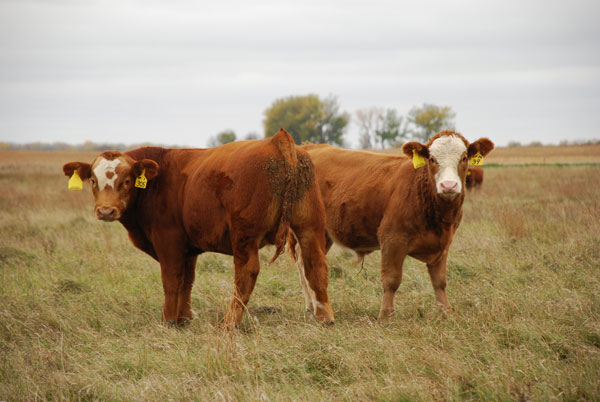Weather and increasing supply weigh on calf demand
Price spreads are wide between weaned, preconditioned calves and their un-weaned counterparts.
October 26, 2019

Cold weather and wet conditions continued to slow offerings and demand at some auctions this week.
“Demand for feedlot-ready calves was light to moderate as many locations in the Corn Belt are still wet,” explained the Agricultural Marketing Service (AMS) reporter on hand for Tuesday’s sale at Miles City Livestock Commission in Montana. “Additionally, many farmers are still tied up with harvest as late plantings have led to a later harvest than usual…The biggest price gaps between preconditioned and non-preconditioned calves existed in grass cattle as very few takers could be found for calves with only one round or no shots.”
Likewise, the AMS reporter at Thursday’s Mobridge Livestock Auction in South Dakota explained there were many cancellations with road and yard conditions too muddy to get trucks in and out.
“Calf preconditioning remains a huge factor in how these calves are received at auction,” said the Mobridge reporter. “Terrible weather and yard conditions, as well as tight margins, are making feeders reluctant to place calves at this time, and they are not willing to take a chance on calves that are more probable to get sick.”
Nationwide, yearling steers and heifers sold from $3 per cwt lower to $1 higher, according to AMS. Steer and heifer calves traded $1-$4 lower.
“Potential health risks have kept most buyers at bay for calves,” say AMS analysts. “However, preconditioned, long-time weaned calves did attract much more of the buyer’s attention, creating wide price spreads.”
Moreover, with harvest now in full swing, some farmer feeders are focusing on getting crops out rather than placing calves, AMS analysts say. “ With most feedlots at or near full capacity throughout most feeding regions, placing cattle has become challenging as empty pens are already spoken for or getting much needed maintenance work completed.”
Despite mixed cash prices, Feeder Cattle futures closed an average of $2.16 higher week to week on Friday, regaining more than the previous week’s decline. Support included the steady to higher cash fed cattle price, increasing wholesale beef values and slightly softer week-to-week Corn futures.
Incidentally, winter wheat planting is progressing at a faster rate than usual, according to the most recent weekly USDA Crop Progress report. For the week ending Oct. 20, 77% was in the ground, which was 6% more than the previous year and 2% more than the average.
Cyclically higher prices ahead
The Livestock Marketing Information Center (LMIC) expects the price for steer calves (600 pounds) sold from August through November to be 5.5% to 6% less than the same time a year earlier; about $9 per cwt less, based on AMS prices. That would be the lowest price level since 2016.
Plus, LMIC points out cull cow prices so far this year are $10 per cwt less than last year, on track to be the cheapest prices since 2009.
“Overall, this year’s estimated cow-calf returns over cash costs plus pasture rent for the Southern Plains is projected to be negative and the worst since 1996 (unadjusted for inflation),” say LMIC analysts. “Three out of the last four years have been in the red.”
However, LMIC also projects cow-calf net returns to begin turning the cyclical corner next year. In the latest Livestock Monitor, LMIC forecasts typical returns over cash costs, plus pasture rent (basis the Southern Plains) at $70-$85 per cow in 2020 and 2021.
Keep in mind, LMIC estimates are not survey-based. Calculations only include cash costs of production and pasture rent. They’re based on a typical fulltime spring-calving, fall-weaning Southern Plains operation.
“The returns are useful only in a general context,” say LMIC analysts. “The LMIC uses those estimates because producer return is a key factor influencing national herd growth/contraction.”
Fed cattle prices look steady to higher
Negotiated cash fed cattle trade remained undeveloped through Friday afternoon, based on USDA reports, except for the Southern Plains. Live sales there on Thursday were at $110 per cwt, which was $1 higher in Kansas and $2 higher in the Texas Panhandle.
“Several areas of the Northern Plains still have tightly-held negotiated cattle on show lists priced in the $115-$116 area, willing to trade on Saturday morning if needed, as the previous three weeks,” explained AMS analysts.
Through Thursday, the Five Area direct weighted average steer price was $109.95 per cwt on a live basis and $174.88 in the beef.
Live Cattle futures closed an average of $1.70 higher week to week on Friday ($1.40 to $2.45 higher).
“Better closeouts are coming down the line, and they will be here soon,” says Andrew P. Griffith, agricultural economist at the University of Tennessee, in his weekly market comments.
“The finished cattle market is attempting to break through price resistance at $110. If there is any follow through next week, then it is likely the fed cattle market will officially be out of its fall slump and heading toward better days.”
Wholesale beef values gained seasonally as production increases (see “Beef demand keeps…).
Choice boxed beef cutout value was $7.40 higher week to week on Friday at $225.44 per cwt. Select was $6.80 higher at $199.84. That’s $9.88 higher for Choice over the last two weeks; $11.16 higher for Select.
About the Author(s)
You May Also Like




.png?width=300&auto=webp&quality=80&disable=upscale)
